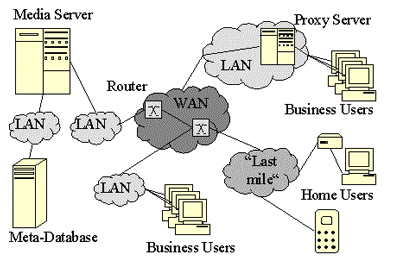
This issue in pdf Subscription Archive: Next issue: October 2005 |
|
||||
ADMITS: Adaptation in Distributed Multimedia IT Systemsby Laszlo Böszörmenyi The ADMITS project, at the Institute of Information Technology of the University of Klagenfurt (ITEC), has developed an experimental distributed multimedia system for investigations in adaptation, an increasingly important tool for resource and media management in distributed multimedia systems. In recent years, a large number of papers have been published on the subject of adaptation in multimedia systems. These papers reflect a diversity of interpretations, however, generally have a rather limited scope. Best-effort scheduling and worst-case reservation of resources are two extreme cases, neither being well suited to cope with large-scale, dynamic multimedia systems. A middle course can be found in a system that dynamically adapts its data, resource requirements, and processing components to achieve user satisfaction. Nevertheless, there is no agreement about the questions of where, when, what and who should adapt. A distributed multimedia system comprises several types of components, such as media servers, meta-databases, proxies, routers and clients. In addition, a large number of adaptation possibilities exist, from simple frame dropping up to virtual server systems that dynamically allocate new resources on demand. The main problem is determining which kind of component can best be used for each kind of adaptation. In the frame of the ADMITS project, we are seeking answers to exactly this basic question, and to a number of related questions. In building the experimental system, we explore a number of possible adaptation entities (server, proxy, clients, routers), and implement and evaluate different algorithms for media, component and application-level adaptations. Experimental data is also collected in order to gain insight into when, where and how to adapt, as well as how individual, distributed adaptation steps interoperate and interact with each other. The overall architecture of the experimental system is depicted in the Figure.
The individual components play different roles in the adaptation process. They are connected physically by the network, and ‘semantically’ by MPEG-7 Multimedia Descriptions and MPEG-21 DIA Descriptions that flow over the network. The reliance on these international standards makes the components interoperable with any standard-compliant components developed elsewhere. To our knowledge there exists no other system that handles adaptation in such a comprehensive and interoperable way. Since ADMITS is a research project, its main emphasis is on the publication of papers. A list of these can be found on the home page of ITEC (http://www.ifi.uni-klu.ac.at/ITEC/), under ‘Publications’. However, in order to validate our ideas, but also with the aim of future industrial applicability, a large repository of software tools (called ViTooKi, for Video Toolkit) has been developed. The software tools are highly interoperable and available as open-source software (http://vitooki.sourceforge.net/). The repository is unique in providing a very rich set of interoperable video tools. The following non-exhaustive list gives an overview of the tools and their major features:
One of the most important and unique characteristics of the ADMITS project is the consequent combination of fundamental research with international standards. To reach this goal, ITEC has decided to participate in the standardization processes of the Moving Picture Experts Group (MPEG), especially in the area of MPEG-7 and MPEG-21. A number of contributions in the context of Digital Item Adaptation (DIA) have been submitted by ITEC (in partial collaboration with Siemens AG) and accepted by MPEG in the recent years. Link: Please contact: |
||||


